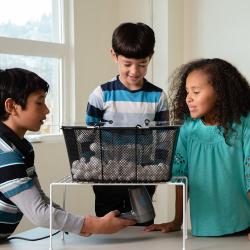Source Institutions
Source Institutions
Add to list Go to activity
Activity link broken? See if it's at the internet archive

In this activity, participants will learn how stars form from the dust and gas that exists in space clumping together. They'll model the star-formation process by adding energy (via a hair dryer) to matter floating in space (ping pong balls) to see how much of it they can get to "clump" in an empty container. The more matter they can accumulate, the larger their model star will be. This activity can be adjusted to make it easier for younger participants. Activity includes a facilitation guide with potential misconceptions, Earth & space science infosheets with NASA connections, table sign, activity & content training videos, and an original star life cycle poster. All public-facing materials also available in Spanish.
- Under 5 minutes
- 5 to 10 minutes
- Over $20 per group of students
- Ages 4 - adult
- Activity, Game, Model
- English, Spanish
Quick Guide
Materials List (per group of students)
- Wire basket with ⅛” plexiglass cover and white shelf
- Clear collection cup
- Hair dryer
- Polystyrene balls
- Clear measuring tube with red cap and clear box stand
- 3 colored bands and flag labels
- Wide-mouth funnel
- 30-second timer
- Power strip with on/off switch
- Data collection board, dry-erase markers, & eraser
- Stickers
- Twist-ties
- Ruler
- Activity and facilitator guides
- Information sheets (see activity webpage for links)
- Tips for Leading Hands-on Activities
Subjects
-
Earth and Space Science
-
Astronomy
- Origins of Universe
- Stars and Galaxies
-
Solar System
- The Sun
-
Astronomy
-
Mathematics
-
Measurement
- Size and Scale
-
Measurement
-
Physical Sciences
-
Motion and Forces
- Gravity
- Projectile Motion
-
Structure and Properties of Matter
- Mass and Weight
-
Motion and Forces
Audience
Learning styles supported:
- Involves hands-on or lab activities
Other
Foreign language versions of this resource:
Components that are part of this resource:
- Facilitator Guide
- Activity Guide
- Table Sign
- Poster (English)
- Poster (Spanish)
- Flags and Labels (English)
- Flags and Labels (Spanish)
Access Rights:
- Free access
By:
Source Collection
- NISE Network
Rights:
- Creative Commons: Non-commercial Share Alike (by-nc-sa), Sciencenter, 2020
Funding Sources:
- NASA, NNX16AC67A
- NASA, 80NSSC18M0061
